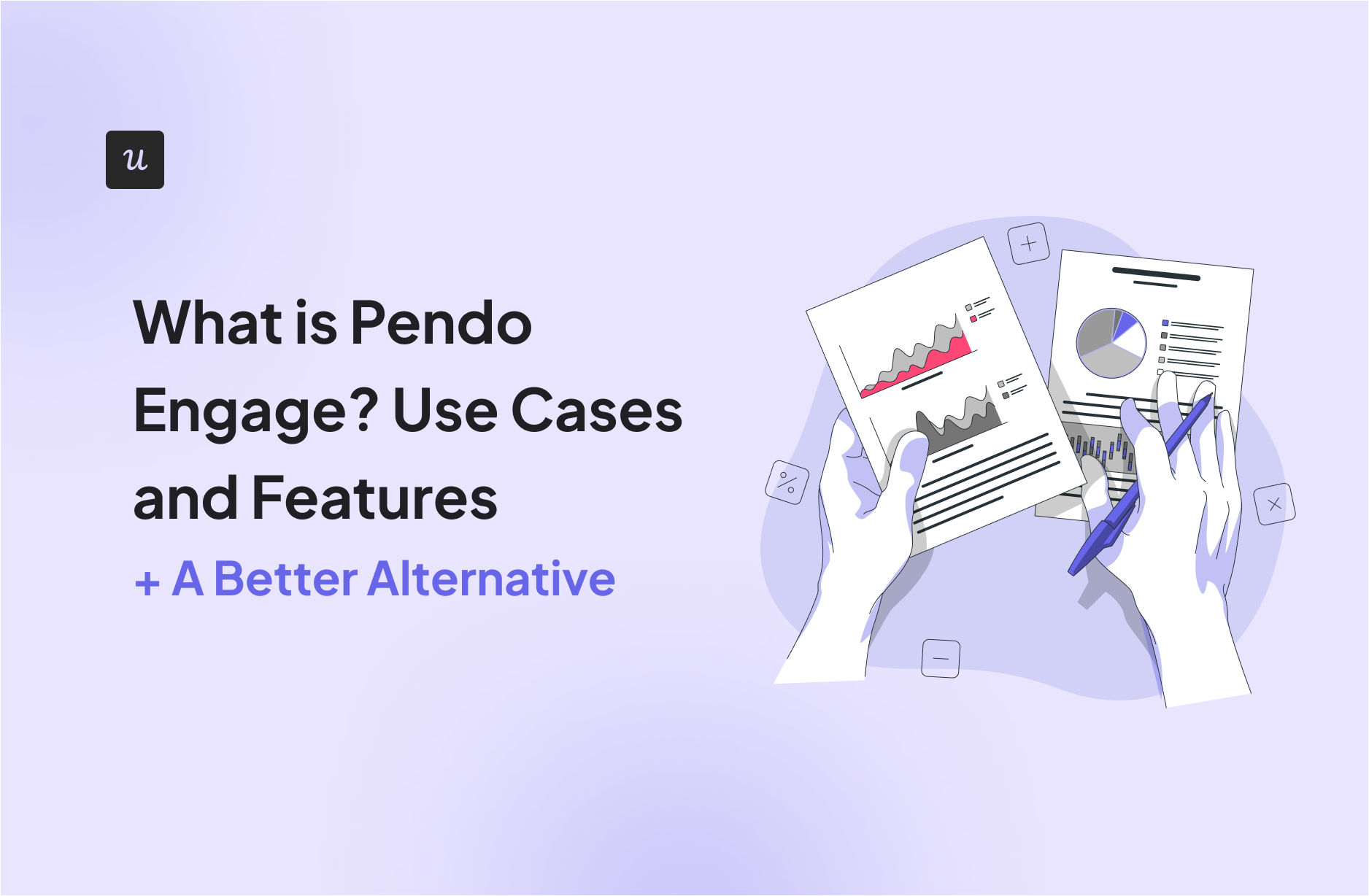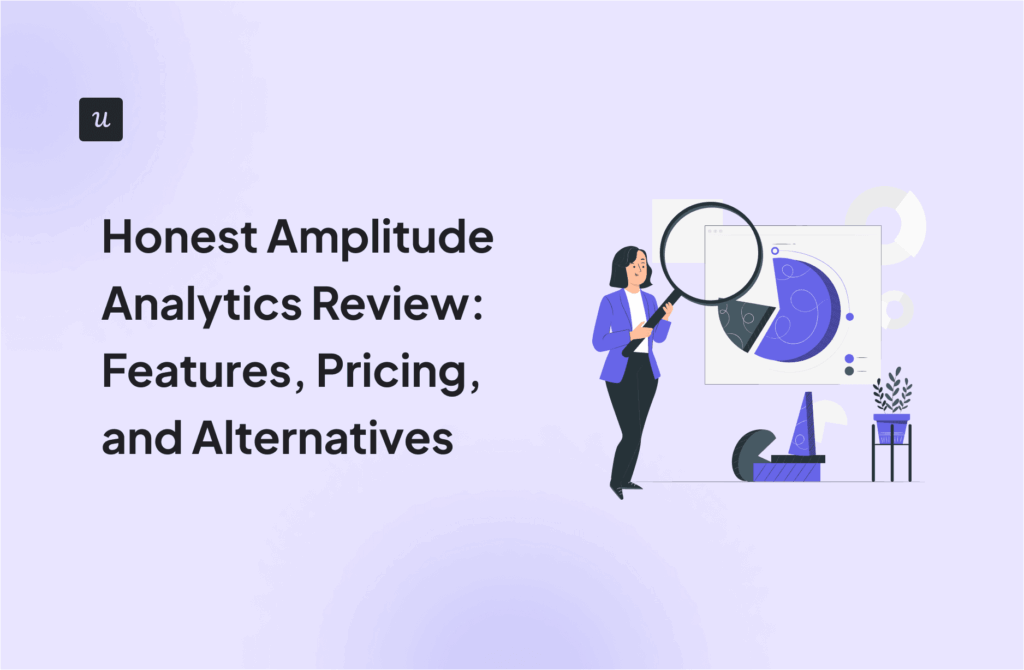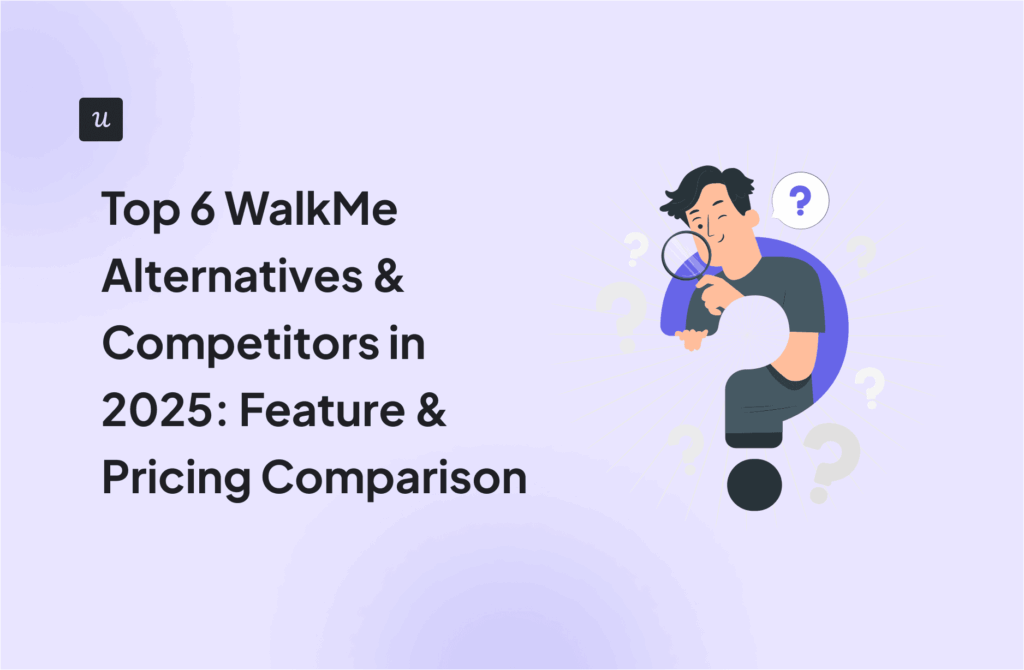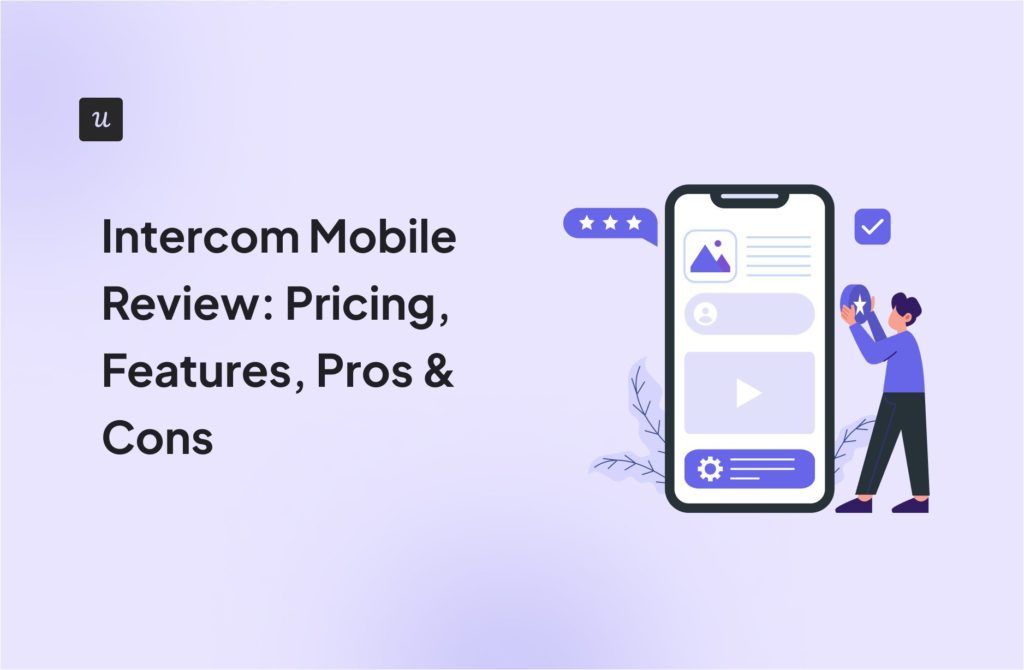
What is Pendo Engage? Use Cases and Features (+ A Better Alternative)
Pendo Engage is a suite of in-app guidance and feedback collection tools to help you track key metrics or usage data.
This guide will go over the benefits of using Pendo Engage, what it’s most commonly used for, how much it costs, and the reasons why you might need an alternative!
If you decide that Pendo Engage isn’t the right fit for your needs, then we suggest you try an alternative – get a free Userpilot demo to see if our platform would be a better match!
Get The Insights!
The fastest way to learn about Product Growth, Management & Trends.
What is Pendo Engage?
Pendo Engage refers to Pendo’s suite of tools to streamline customer onboarding through in-app guidance, collect customer feedback through in-app surveys, and provide an overview of key metrics through analytics dashboards.

Pros of using Pendo Engage
There are quite a few benefits to using Pendo Engage as your adoption platform:
- No-code. Because Pendo is a no-code product adoption platform, your product marketers and customer success managers won’t be bottlenecked by an over-reliance on engineering resources. Most flows and surveys within Pendo can be created without writing a single line of code.
- Custom themes. Pendo’s theme customization capabilities let you create different color palettes to ensure that all in-app guidance aligns with your brand assets and native UI. It’s worth noting that you’ll only be able to customize themes after installing the Pendo snippet.
- Flexible dashboards. Pendo has a wide array of dashboard widgets you can add to your homepage. These track key metrics like MAUs, feature adoption, product stickiness, poll results, guide engagement, and NPS score.
- Multi-platform analytics. Pendo’s mobile compatibility lets you track analytics across both platforms. As a result, you’ll be able to extract insights into how users behave differently when using your product on another platform.
- Integrations. The Pendo integration gallery includes over 50 third-party tools that you can connect to the platform. These include popular software like HubSpot, Intercom, Jira, and Okta. At present, only a few integrations, including Salesforce, Zendesk, Segment, and Workato, support two-way data syncing, while others offer one-way data flow for analytics or targeting purposes.

What is Pendo Engage used for?
Adoption, analytics, and feedback are the three most common use cases for Pendo Engage.
Here’s a quick look at each of them:
- Product adoption. Product adoption is the primary use case for Pendo and its alternatives. Being able to streamline the onboarding, activation, discovery, and adoption of products for new users. This is carried out through Pendo’s in-app guidance and UI patterns.
- Product analytics. Product analytics is a standard offering among product adoption platforms, and Pendo stands out with customizable widgets and deep segmentation.
- User feedback. User feedback can be collected through Pendo’s no-code in-app surveys and then be reflected on your dashboard through the many widgets that Pendo offers. This helps you collect and review data all on the same platform.
Pendo Engage’s functionalities for user onboarding
Because user onboarding is a core use case for Pendo, let’s have a look at the relevant onboarding features you can deploy:
- Guide layouts. There are different guide layouts you can use when building onboarding flows with Pendo. These include Pendo’s templates for tooltips, banners, and lightboxes that help you quickly put flows together.
- Flow triggers. The activation options let you set different conditions under which an onboarding flow should be triggered. These include users interacting with a tagged element, using a particular type of device, landing on a specific URL, or matching a specified segment.
- Localization settings. Pendo’s content localization lets you control whether an onboarding flow triggers based on a user’s language. Manual translation via. XLIFF files are supported by default, while AI-powered localization is available as an add-on for teams looking to automate the process.
- Onboarding module. Pendo lets you add an onboarding module to the in-app resource center in just a couple of clicks. You’ll then be able to customize the progress icon, text font/styling, and change the color to bring it in line with your existing brand palette.

Pendo Engage’s functionalities for product adoption
Product adoption is another core use case for Pendo which is why it should come as no surprise that there are certain features and functionalities made specifically for it:
- Product analytics. Pendo’s product analytics can highlight usage patterns, identify areas of your product that go unnoticed, and surface other actionable insights. Some of Pendo’s analytics tools included paths, workflows, funnels, and retention, with the latter being able to track cohort churn over time.
- Feature engagement. The dashboard widgets we mentioned earlier make it possible to track feature engagement across multiple metrics from a single screen. You’ll be able to track feature engagement based on click volume and see which users interact with different features.
- User guides. Pendo has templates for tooltips, banners, and lightboxes, all of which drive product adoption by guiding users through the early stages of their customer journey. It also lets you add embedded content to your app to make your in-app messages less intrusive.

- Feedback collection. Pendo enables customer feedback collection through various methods such as NPS surveys, polls, or input fields within flows. NPS surveys created with Pendo can be delivered via email and in-app surveys, which maximizes response rates.
- In-app resource center. Pendo’s in-app resource center makes product documentation and guides accessible to users within the application itself. It’s worth noting that Pendo includes only one resource center with limited functionality on all paid plans except Ultimate.

Pendo Engage’s functionalities for product analytics
Next, let’s take a look at Pendo’s product analytics capabilities and how they report key data:
- Native analytics. The majority of Pendo’s engagement and adoption metrics are tracked natively rather than through third-party integrations. This helps you see the exact number of interactions, clicks, and views for each product area or in-app guide.
- Paths. The Pendo Paths report provides an overview of the paths that users take to get to a certain page or the paths they take after leaving a specific page. You can even sort path data by visitor ID, date, or segment.

- Retention. The retention analytics dashboard on Pendo shows you detailed cohort retention data, allowing users to track user engagement over time. To further filter the data, you can toggle between users and visitors, adjust the period, or only view retention metrics for a certain segment.

- Funnels. Pendo’s funnel analysis capabilities show you the number of unique visitors that have viewed a funnel, the number of attempts that were made to get through a particular funnel, and the average amount of time it takes to finish each funnel, along with overall completion rates.

- Analytics widgets. The home dashboard on Pendo gives you control over which widgets you’d like to include or delete. You can add widgets that track metrics like guide views, time-on-app, feature adoption, and specific product goals.
- Third-party integrations. Pendo integrates with popular software like Salesforce, Slack, Intercom, Segment, and others. Connecting these third-party tools helps you share data, but only a few let you sync metrics both ways.
Pendo Engage’s functionalities for user feedback
Finally, let’s go over Pendo’s user feedback functionality:
- Pendo polls. The no-code polls from Pendo are a quick way to collect feedback from a large number of users without any engineering resources. For instance, you could create CSAT surveys that let respondents rate the product on a scale of one to five.

- Feedback forms. Pendo Feedback lets you trigger in-app feedback forms so customers can share their thoughts while they’re actively using the product. This leads to higher response rates and more accurate insights.

- Mobile reviews. Developers who use Pendo for their mobile apps will be able to gather reviews for the Google Play or iOS App Store. This not only provides targeted feedback from mobile users but also improves your standing in app stores and increases the likelihood of new user acquisition.
- Segmented feedback. Pendo allows you to filter all user feedback based on the segment that a respondent is in, the amount of time they spend using your product, and various other attributes to help you hone in on insights from high-value customers.
- Pendo Listen. It‘s a tool that lets you gather and organize all the feedback you’ve gathered to analyze it with AI, validate ideas, and create a user-centered roadmap.

Pendo Engage pricing
Pendo has a free version, but its uses are quite limited since certain core features are excluded, and usage volume is capped at just 500 monthly active users (MAUs).
As for the paid plans, Pendo does not publicly disclose its pricing. Instead, you’ll need to contact their sales team for a custom quote.

However, based on user feedback and industry discussions, it’s well known that Pendo is often perceived as expensive and has a complex pricing structure, especially for startups or smaller teams. The cost depends on several factors, including:
- Number of MAUs (Monthly Active Users). The more users you track, the more you pay.
- Feature set. Advanced analytics and enterprise features increase the cost.
- Add-ons. Depending on your plan, some capabilities, such as session replays and certain guide enhancements, are only available as paid add-ons or higher-tier plans.
A common sentiment among Pendo customers is that pricing is a major barrier to adoption. Here’s what one reviewer on G2 had to say:
“It is quite expensive, and this has held us back from implementing Pendo Mobile, which we sorely need for our mobile apps to have the same analytics and communication ability as we have in our web app.”
Why you might need a Pendo Engage alternative?
While you could use Pendo, there are a few drawbacks to choosing it as your product adoption platform:
- Expensive and complex pricing. The lack of transparency in Pendo’s pricing model makes it difficult for new users to figure out whether or not they can afford the software long-term.
- Locked features. In addition to the restrictive limitations of Pendo’s free version, the entry-level Base plan still runs into multiple feature paywalls that prompt you to upgrade to the Core or Pulse plan.
- Steep learning curve. While Pendo is an inherently complex product, some users report a steep learning curve due to setup complexity and UI design, particularly those without technical backgrounds. Reviews from Pendo customers on G2 frequently cite difficulties with setup and navigation in particular.
- Data lag. Pendo’s analytics dashboards only update once per hour. This means that you won’t be able to see real-time data or check where your metrics currently stand at a glance. If your company values rapid experimentation and data analysis, then Pendo isn’t the best fit.
Userpilot: A better alternative to Pendo for product growth
Userpilot is a full-suite product growth platform for user onboarding, product adoption/analytics, and user feedback.
There are quite a few reasons why our software may be a better fit for certain use cases compared to the Pendo platform. In addition, Userpilot’s pricing is more transparent than Pendo’s, with public base rates and fewer feature-based paywalls, though final pricing still depends on your MAU volume and feature needs.
Userpilot’s functionalities for user onboarding
- No-code builder. Userpilot’s wide range of UI patterns, like modals, tooltips, and slideouts, lets you build flexible in-app flows without writing a single line of code. Each of these patterns also feeds data to analytics dashboards so you can monitor content engagement.

- User segmentation. Another differentiating Userpilot feature worth noting is the platform’s user segmentation capabilities. This makes it possible to build advanced segments with custom filters based on the in-app behavior, company/persona, and NPS score of each user.

- Onboarding checklist and analytics. When you build a user onboarding checklist with Userpilot, you’ll be able to track the engagement and completion rates to see how many customers are actually completing them.

- In-app resource center. Userpilot’s in-app resource centers let you add modules and embed resources in multiple formats. There are also AI-powered SaaS localization features that you can use to translate your knowledge base resources into different languages.

- AI-assisted user guides. The AI writing assistant built into Userpilot can help you improve your product’s microcopy and increase user adoption as a result. All these writing tweaks can be made in seconds without having to edit manually or use any code.

Userpilot’s two-way integrations
- HubSpot and Salesforce two-way integrations for creating an omnichannel customer experience. Userpilot’s integrations with HubSpot and Salesforce let you sync data with your CRM platform both ways. The HubSpot integration helps you personalize flows based on event data:

On the other hand, Userpilot’s Salesforce integration lets you send customer satisfaction data, such as NPS scores, gathered in Userpilot, to your Salesforce account. You can then use this data to follow up with your customers across different channels like SMS, WhatsApp, Facebook Messenger, and more!

Userpilot’s functionalities for product adoption
- Session replays: Filter session replays by user properties or events to see exactly how users interact with your product. You can even mark bugs, add notes, and share recordings across your team for better collaboration.

- Feature adoption dashboard. The feature engagement dashboard helps you visualize adoption rates for each individual feature. You can then use these insights to promote core features that are underutilized or include the most popular features in your onboarding flows.

- Create feature announcements. The in-app announcement capabilities of Userpilot let you announce new features or updates from within your product to drive feature adoption. This will provide far greater exposure than featuring the updates in your newsletter.
- Create interactive walkthroughs code-free. Interactive walkthroughs, which are better for helping new users retain information, can be built within Userpilot completely code-free. This gives users the opportunity to learn by doing instead of going through linear product tours.

Userpilot’s functionalities for product analytics
- Path analysis. Userpilot’s user path analysis dashboard shows you the exact steps that your users take when navigating throughout your app. You’ll be able to set a starting/destination point to see where people go before or after landing on a specific page.

- Trend analysis. In addition to gathering customer data and product insights, Userpilot also helps you conduct trend analysis reports to identify patterns in user behavior. You can also break down data with filters or change the period to see how metrics change over time.

- Retention cohort tables. Userpilot lets you track the retention rates for each cohort through a retention table that shows you the retention rate across multiple months. This cohort retention analysis is helpful for identifying long-term behavioral patterns.

- Multivariate testing. In addition to product experiments and A/B testing, Userpilot also supports multi-variate testing, so you can test multiple different versions simultaneously. This streamlines the conversion rate optimization (CRO) process and gets you faster results than A/B testing.

- Analytics dashboards. Userpilot’s analytics dashboards show you core SaaS metrics like activation rates, product stickiness, monthly/daily active users, conversion rates, and more. This helps you keep an eye on the metrics used to measure product success.

- AI analytics. If you don’t have in-house data analysts on your team, then it can be hard to visualize the data available to you. Thankfully, you can use Userpilot’s upcoming AI analytics capabilities to understand data through the power of artificial intelligence.

Userpilot’s functionalities for user feedback
- In-app surveys. Userpilot’s in-app survey builder comes with 14 unique templates you can customize based on your needs, or you can create surveys from scratch. You’ll also be able to trigger surveys contextually based on user actions, behaviors, or segments.

- Survey analytics. In addition to gathering data through surveys, Userpilot also helps you track responses through in-depth survey analytics. This lets you compare the completion rates for each survey and track individual responses so you can identify trends in the answers.

- Advanced NPS capabilities. The Userpilot NPS dashboard lets you analyze NPS responses to see which problems or features have the biggest impact on NPS scores. You’ll also be able to tag responses that share similar themes or cite the same issues.

Why is Userpilot better than Pendo?
There are three main advantages Userpilot has over Pendo as a product growth platform:
- Real-time analytics. Unlike Pendo’s hourly analytics, Userpilot dashboards display analytics in real time. This ensures that the data you see will be up to date, regardless of when you decide to check on your key metrics.
- Product experimentation options. While both Userpilot and Pendo support A/B testing for in-app flows, Userpilot makes product experimentation easier to set up and more flexible. This will help you identify the most effective in-app guidance flows and elements.
- In-app engagement. Userpilot’s no-code flow builder lets you build personalized tours and flows to help users get acquainted with your product. This increases in-app engagement rates and boosts long-term product adoption.
Userpilot pricing
Userpilot’s pricing plans range from $299/month for entry-level customers to the quote-based Enterprise tier for large organizations.
Here’s a detailed breakdown of pricing plans:
- Starter. Userpilot’s entry-level plan is accessible only via an annual subscription, priced at $299 per month. It includes all core features like all UI patterns, user segmentation, analytics dashboards/reports, feedback collection, and customization options.
- Growth. The Growth plan starts at $799/month with additional features such as in-app resource centers, advanced triggers, AI-powered localization, event-based triggers, EU hosting, and a dedicated customer success manager.
- Enterprise. Finally, the Enterprise tier uses custom quote-based prices and contains all the features from the previous two plans. It also has unique features like custom permissions/roles, priority support, single sign-on, access to premium integrations, and GDPR/SOC 2 compliance.

Conclusion
A product team that uses Pendo will be able to create better product experiences than one without any onboarding software at all.
That said, there are alternatives like Userpilot that apply more transparent pricing practices and a wider array of features to choose from.
If you want to provide a more personalized product/service to your customers and represent your brand with more sophisticated in-app flows, get your free Userpilot demo today!
Userpilot strives to provide accurate information to help businesses determine the best solution for their particular needs. Due to the dynamic nature of the industry, the features offered by Userpilot and others often change over time. The statements made in this article are accurate to the best of Userpilot’s knowledge as of its publication/most recent update on May 9, 2025.






